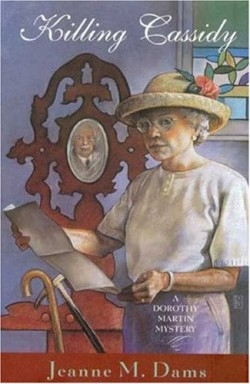Killing Cassidy
When an old colleague dies in Indiana, Dorothy Martin is summoned back to the Midwest from her expatriate exile in England. Martin enthusiasts know her as a feisty, seventy-year-old widow with a quirky hat fetish, remarried now to a retired Scotland yard inspector. In this, her sixth adventure, she must confront her feelings of being back in the university town where she spent most of her life while being embroiled in the mystery of her friend’s seemingly natural death from pneumonia.
The victim, ninety-year-old emeritus biochemist Kevin Cassidy, has bequeathed Dorothy a note: “You see, my dear, someone is trying to kill me. When you read this, they will have succeeded.” Rather than question Cassidy’s senility, her husband Alan trusts Dorothy’s instincts and lends his Scotland-yard insight.
Dams, a retired teacher living in South Bend, Indiana, has re-mastered the British cozy style with mid-western flair. She creates a whole cadre of unlikely suspects for Dorothy and Alan to interrogate: the victim’s neighbors—a virtual Rambo and an environmental activist—the attending physician, the lawyer, the local evangelist, the disenfranchised niece, and even the local police chief.
Alan has no clout in the states and, in fact, the Yanks distrust him. Dorothy relies on contacts, among them former students, to ferret out information. Their digging leads them to be implicated in murder charges when one of the suspects is found dead.
In Dorothy and Alan’s tender interchanges, Dams captures the reality of a couple’s life. They tolerate each other’s quirks: her hats and his tourist need to acquire every item of tiger-emblazoned memorabilia in the university store. The geriatric newlyweds share love and intimate moments in their hotel off-camera, as well as arthritis pains, and case notes. Most importantly, they understand the subtle nuance of each other’s thoughts and desires. Dorothy notes his frustration with a legal system he cannot affect; Alan senses her disappointment in the homogenized modernization of her home town. On a tour of the foliage along the Ohio River, while Dorothy peels acorn skins, he goads her to reveal her feelings:
“You also thought,” Alan said gently, “that you would dazzle your friends with your English husband and your detective expertise. Instead you find yourself—what? Rejected?”
“No,” I said shortly. Alan was trying to help. I would try to be fair. “Not rejected, exactly. Just—set aside. Unimportant. Not in the scheme of things anymore. And also—ineffectual would be the word I suppose.”
Alan and Dorothy wind up anything but ineffectual in their solution of the mystery. Dams cunningly includes an ordinary misinterpretation of Medicaid laws (that Dorothy must explain to her British husband and the reader) as the murder motive. The case ends in a running chase scene through the town’s historic house district where Dorothy jumps into the river after the perpetrator. New readers will feel compelled to read all the Dorothy Martin mysteries, while followers will be anxious for her next exploit.
Reviewed by
Jo-Ann Graziano
Disclosure: This article is not an endorsement, but a review. The publisher of this book provided free copies of the book to have their book reviewed by a professional reviewer. No fee was paid by the publisher for this review. Foreword Reviews only recommends books that we love. Foreword Magazine, Inc. is disclosing this in accordance with the Federal Trade Commission’s 16 CFR, Part 255.

